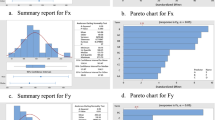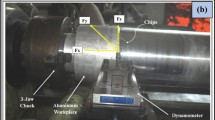Abstract
Nickel-based superalloy Inconel718 has excellent properties such as good fatigue resistance, creep resistance, oxidation resistance and corrosion resistance. It has been widely used in aerospace industry. However, nickel-based superalloy is a kind of typical difficult-to process-material. The alloying elements which enhanced material exist in the form of high hardness compound (TiC, NbC and other interphase hard point). These high hardness compounds led to complicate cutting deformation, high cutting temperature, large cutting force and severe tool wear. According to the characteristics in cutting Inconel718 and the microstructure of cemented carbide tool, the wear properties and mechanism of carbide tool in cutting Inconel718 process are revealed by multi-scale analysis method. The main wear forms that wear debris peeled from the tool substrate are given and the evolution mechanism of tool wear caused by the crack in the cutting process is deeply studied.
Similar content being viewed by others
References
S. Ranganath, C. Guo, S. Holt, Experimental investigation into the carbide cracking phenomenon on Inconel718 superalloy material, in: Proceedings of the ASME – International Manufacturing Science & Engineering, 2009.
T. Özel, Y. Karpat, Predictive modeling of surface roughness and tool wear in hard turning using regression and neural networks, Int. J. Mach. Tools Manuf. 45 (2005) 467–479.
J. Díaz-Álvarez, J.L. Cantero, H. Miguélez, X. Soldani, Numerical analysis of thermomechanical phenomena influencing tool wear in finishing turning of Inconel 718, Int. J. Mech. Sci. 82 (2014) 161–169.
A. Attanasio, E. Ceretti, S. Rizzuti, D. Umbrello, F. Micari, 3D finite element analysis of tool wear in machining, CIRP Ann. Manuf. Technol. 57 (2008) 61–64.
Y.C. Yen, Modeling of Metal Cutting and Ball Burnishing: Prediction of Tool Wear and Surface Properties, Ohio State University, 2004.
L.J. Xie, Estimation of Two-Dimension Tool Wear Based on Finite Element Method, University of Karlsruhe, 2004.
M. Binder, F. Klocke, B. Doebbeler, An advanced numerical approach on tool wear simulation for tool and process design in metal cutting, Simul. Model. Pract. Theory 70 (2017) 65–82.
Y.C. Yen, J. Sohner, B. Lilly, et al., Estimation of tool wear in orthogonal cutting using the finite element analysis, Mater. Process. Technol. 146 (2004) 82–91.
S.J. Yan, D.H. Zhu, K.J. Zhuang, X.M. Zhang, H. Ding, Modeling and analysis of coated tool temperature variation in dry milling of Inconel 718 turbine blade considering flank wear effect, J. Mater. Process. Technol. 124 (2014) 2985–3001.
L. Filice, D. Umbrello, F. Micari, FE analysis of tool wear in orthogonal cutting, in: Proceedings of the Second International Conference on Tribology in Manufacturing Processes, Nyborg, 2004, 187–194.
R.T. Peng, J. Li, X.Z. Tang, Z. Zhou, Simulation of tool wear in prestressed cutting superalloys, Mater. Sci. Forum 10 (2016) 42–45.
X. Dong, C. Liao, Y.C. Shin, Machinability improvement of gear hobbing via process simulation and tool wear predictions, Int. J. Adv. Manuf. Technol. 9 (2016) 2771–2779.
K. Cheng, X. Luo, R. Ward, R. Holt, Modeling and simulation of the tool wear in nanometric cutting, Wear 7 (2003) 1427–1432.
K.J. Zhuang, D.H. Zhu, X.M. Zhang, H. Ding, Notch wear prediction model in turning of Inconel 718 with ceramic tools considering the influence of work hardened layer, Wear 313 (2014) 63–74.
J. Kümmel, K. Poser, F. Zanger, J. Michna, V. Schulze, M. Hua, Surface layer states of worn uncoated and TiN-coated WC/Co-cemented carbide cutting tools after dry plain turning of carbon steel, Adv. Tribol. 7 (2013) 427–432.
J.W. Yu, M. Cheng, S.H. Yin, G.Z. Xie, X.L. Zhou, A study of machining characteristics of YG8 in high speed grinding, Key Eng. Mater. 3 (2011) 108–112.
A.N. Stroh, The formation of cracks as a result of plastic flow, Proc. R. Soc. A 223 (1954) 404–414.
N.P. Suh, The delamination theory of wear, Wear 26 (1973) 111–124.
H. Attia, S. Tavakoli, R. Vargas, V. Thomson, Laser-assisted high-speed finish turning of superalloy Inconel718, CIRP Ann. Manuf. Technol. 59 (2010) 83–88.
H. Lim, M.G. Lee, J.H. Kim, B.L. Adams, R.H. Wagoner, Simulation of polycrystal deformation with grain and grain boundary effects, Int. J. Plast. 27 (2011) 1328–1354.
M.C. Sun, Mechanical Properties of Metal, Harbin Institute of Technology Press, 2003. p. 71 (in Chinese).
H.C. Chen, Z.H. Yang, A model on cavity failure in metal, Metal Sci. Technol. 4 (1986) 18–24 (in Chinese).
Author information
Authors and Affiliations
Corresponding author
Rights and permissions
About this article
Cite this article
Fan, YH., Wang, T., Hao, ZP. et al. Research on tool wear based on multi-scale simulation in high speed cutting Inconel718. Archiv.Civ.Mech.Eng 18, 928–940 (2018). https://doi.org/10.1016/j.acme.2018.02.001
Received:
Accepted:
Published:
Issue Date:
DOI: https://doi.org/10.1016/j.acme.2018.02.001




